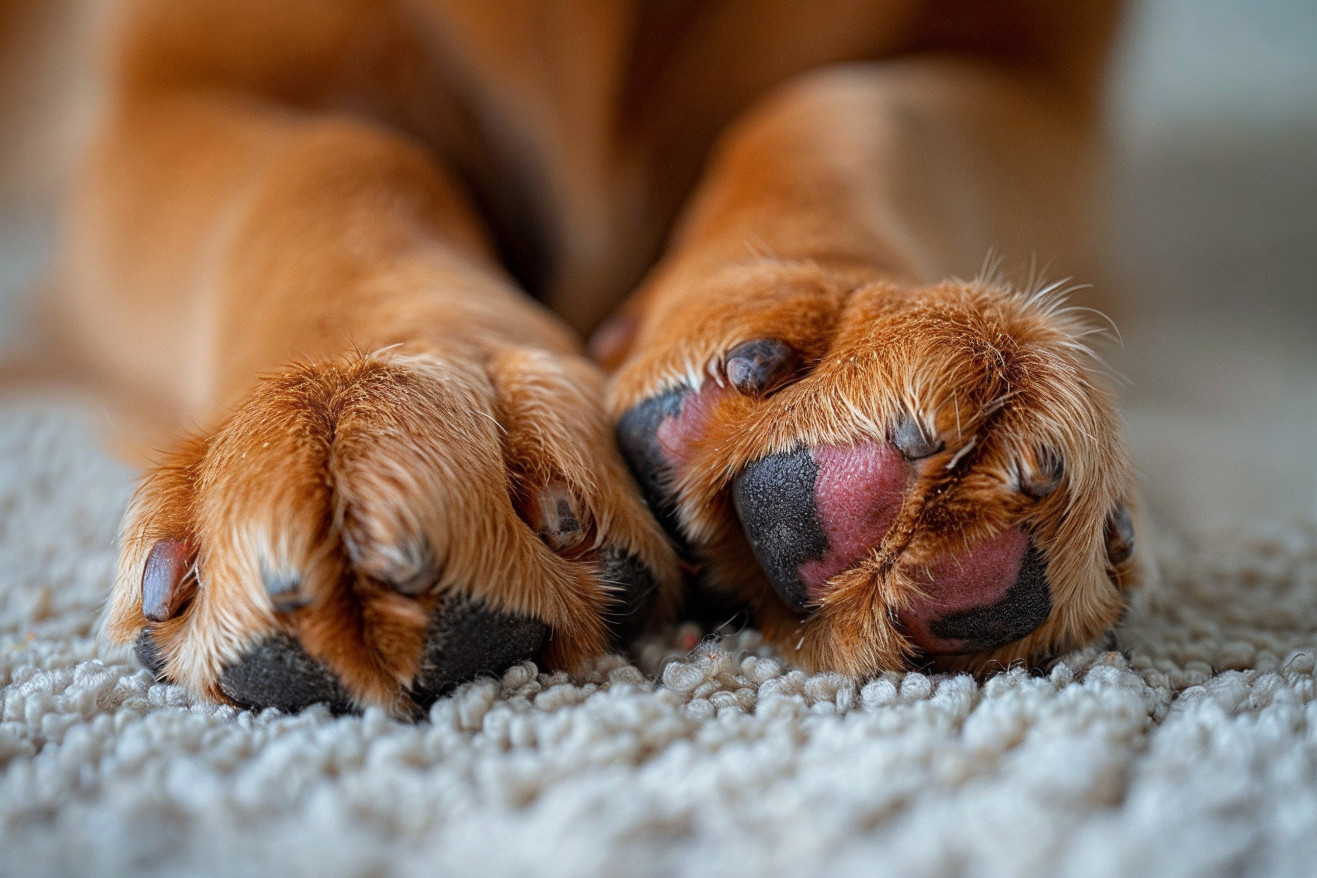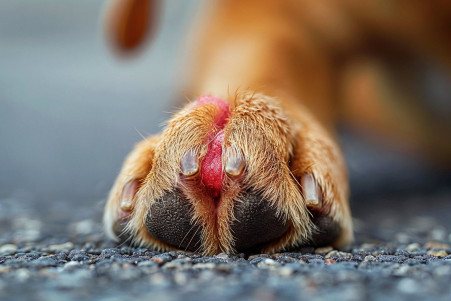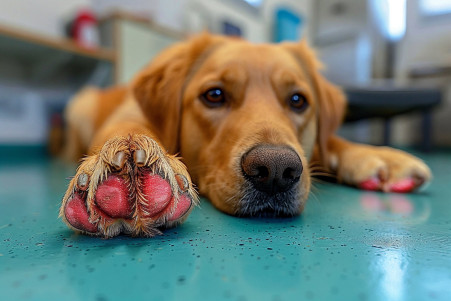Why Are My Dog's Paw Pads Red? Causes and Remedies
29 March 2024 • Updated 29 March 2024

If you’ve noticed that your dog’s paw pads are red and you’re not sure why, you’re not alone. There are many reasons why a dog’s paws might become red, ranging from environmental causes like walking on hot pavement or coming into contact with ice melters to medical causes like allergies, wounds, bacterial infections, and autoimmune diseases. That’s why it’s important to understand what’s causing the redness so you can help your dog feel better.
As we discuss potential remedies, we’ll also be drawing on a variety of expert opinions and research studies from the veterinary field. This information will help explain the many causes of paw pad discoloration in dogs and help you understand how to best recognize and treat them. Our in-depth look is designed to give you the information you need to make sure your dog’s paws stay in good shape.
What is causing my dog's paw pads to be red?
What Causes Red Paw Pads in Dogs?
According to veterinarians, there are a number of reasons why a dog's paw pads may be red and inflamed. One of the most common reasons is allergies, whether they're environmental allergies to things like pollen and dander or food allergies to specific ingredients, according to a WikiHow article. These allergies can cause an immune response that results in inflammation and redness in the paws.
Another common cause of red paw pads is external injuries. As PetsRadar explains, burns from hot pavement, cuts from sharp objects, and abrasions from overexertion can all lead to irritated, inflamed paws. In addition, foreign objects like thorns or glass shards stuck in the paw can cause redness and swelling in a specific area.
Infections, including bacterial and fungal infections, can also cause discoloration in the paw pads. VCA Animal Hospitals says that bacteria, yeast, and parasites are all infectious causes of pododermatitis, or inflammation of the feet. These infections can cause red, swollen paws, nodules, ulcers, and discharge.
Medical issues can also be to blame for red paw pads. As PetMD reports, autoimmune diseases, hormonal imbalances like hypothyroidism or Cushing's disease, and even cancer can cause inflammation and redness in the paws. In these cases, it's important to treat the underlying medical issue.
By knowing the many potential causes, including allergies, injuries, infections, and medical issues, dog owners can more easily figure out what's causing their dog's red paw pads and get them the help they need to feel better.
Home Remedies and Comforting Solutions
Per Dogs Naturally, an Epsom salt soak can help to comfort and cleanse raw paw pads, which will help to reduce swelling and pain. The salt has antibacterial and healing properties, the chamomile will help to soothe, and the aloe vera will help to moisturize and support healing.
Relievet also notes that coconut oil and aloe vera gel can be used to moisturize and soothe dry, cracked paws. Both are antibacterial and antifungal, which can help to fight infections.
If the paws are affected by yeast or bacterial problems, Relievet suggests using diluted apple cider vinegar or baking soda, both of which are antimicrobial. These solutions can help to heal the paws.
An oatmeal bath, which is recommended by PetHelpful, can help to relieve itching and swelling, while cold compresses can help to reduce swelling. EntirelyPets also notes that Epsom salt soaks can help to reduce pain and promote healing.
To help prevent future irritation, HICC Pet suggests using protective paw waxes or balms that can help to shield the paws from environmental irritants. These natural, gentle solutions can help to comfort and prevent further harm.
When to See a Vet
If the redness and irritation in your dog's paws don't go away after a few days of at-home treatments, it's time to see a vet, according to Canna-Pet. If your dog is in pain, limping, or refusing to walk because of their paws, you should see a vet right away.
If you think that an underlying condition like an allergy or an infection is causing the problem, you should see a vet to get a proper diagnosis and treatment, according to WagWalking. If your dog's paws are swollen, have pus, or have open wounds, you should see a vet immediately.
If you're not sure what's causing the red paws or if you've tried at-home treatments and they haven't worked, a vet can help you figure out what's going on. A vet can use a variety of tests and methods to determine what's causing your dog's paws to be red and then treat the issue, according to Canna-Pet.
How to Keep Your Dog's Paws Healthy
Consistently checking your dog's paws for any signs of redness, cuts, or anything stuck in their paw is the best way to keep their paws healthy, according to Tryfi. Catching and dealing with any issues early will help you avoid bigger problems down the line.
Good grooming habits, including keeping your dog's nails and the hair between their paw pads trimmed, will help you avoid matting and other issues, according to Preventive Vet. This will also help keep your dog's paws clean and avoid any potential irritants.
Using protective paw products, including booties and wax, can help protect your dog's paws from hot pavement, ice melt, and other irritants, according to BetterPet. These products will act as a barrier between your dog's paws and the irritants, keeping them safe and comfortable.
If your dog has any allergies or other health issues that could be causing their paw irritation, it's important to manage those issues with your vet's help, according to PawSafe. By getting to the bottom of the issue, you can help prevent future problems with your dog's paws.
Finally, make sure you're walking your dog in safe areas that are free from hazards like broken glass and other sharp objects, according to WebMD. By being aware of your dog's surroundings, you can help prevent any issues with their paws.
Conclusion: How to Help Your Dog Avoid Red Paw Pads
There are many reasons why a dog's paw pads may turn red, from environmental factors to underlying health problems. By learning about the most common causes and taking steps to prevent them, dog owners can help their pets avoid paw pad issues.
While home treatments can help provide relief, it's important to see a veterinarian if the redness doesn't go away or gets worse. With the right care, treatment, and attention, dogs can enjoy healthy, pain-free paws for years to come.
And always remember that addressing red paw pads as soon as possible can help your dog avoid unnecessary pain and potential complications.


